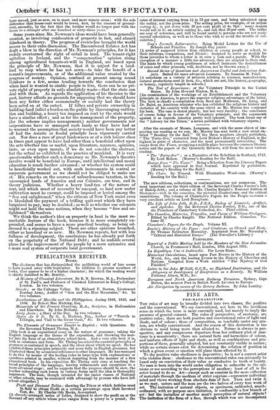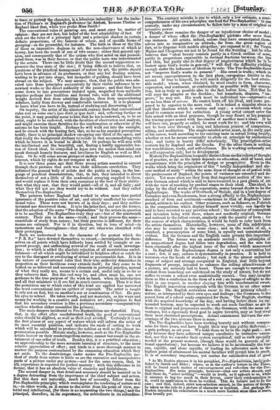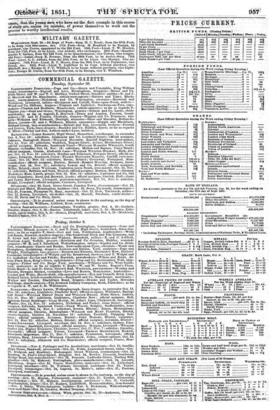FINE ARTS.
PRE-EAPHAELTTISM.
THE rules of art may be broadly divided into two classes, the positive and the conventional. We say conventional, not here in the invidious sense in which the term is more currently used, but merely to imply the presence of general consent. The rules of perspective, of anatomy, are positive rules; there are both positive and conventional rules of light and shade, and of colour; those of composition, as teachable under any sys- tem, are wholly conventional. And the reason of this distinction is too obvious to need being more than alluded to. Nature is always in per- spective, and any conspicuous departure from her ordinary plan of ana- tomy is a monstrosity; there are natural facts and harmonies of colour, and uniform effects of light and shade, as well as combinations and pro- portions of these, generally adopted, but not constantly visible in nature ; while no certain means exist for determining the relation of position in which a given event or emotion will place those affected by it. To the positive rules obedience is imperative ; he is not a correct artist who violates them : obedience to the conventional rules can rationally be based only on conviction of their value as conducive to truth or beauty. No men is born into the world under obligation to subscribe to the opi- nions or see according to the perceptions of another; least of all is the artist bound to do so. Art—except such as consists in the mere collection of materials through the medimn of strict copyism —represents individual mind and views working from absolute data of fact Turn and twist it as we may, nature and the man are the two halves of every true work of art. The imitation of natural objects, as specimen; =blended, =sub- ordinated, with no purpose save imitation, is confessedly a low branch of art: but the imitation of another man's perception of natural objects? The imitation of the form of a face, through which von are incompetent
Raphael liked that, while you preferldiss Smith ?
The conventional rules of Tanning- Are, and :niust seger be, matter of opinion,: .they are not;fact, lait belisfof the best adaptability of fact. Of such are the rules of a .principal ' t'.; and a principal shadow * pertain definite proportaons, of thei Wan iii allow,: and di SPeOltuiloislisOf
groupingas the pyramida4 f :de. The faith-in ilia* ef the'bire.
of these as.iraperatiVe &a art, the non-observance of. which is heresy, has been-the result of one f 'trio causes; either that general opt-; neon, nd ethaseqtaintly ilia Ortlielaitlite *lie' first acted on:and Memel- gatai them, was in their-favdur-or, that the public taste was indoctrinated by the artists There tats be little pat that the -Seceird-supposition re- presents the true state of thi lose; it being difficult to believe that, on questions of thellitioVailiganagement of nature by art, the public should have been in advance ef. ita professor; or that any but floating notions, waiting to be put into shape, but incapable of-guiding, should have been abroad on the subject. ' We may-assume,, then, that the public was edu- cated into thee - principles _successively by their visible influence in re- nowned workser the direct autbortty of the painter ; and that they have come down- to: late generations -,ir: s si ted lip* magnified from methodic
praetice perhaps' into :tradition- and formal rule, with all the additional weight derived first from admiring disetles, then from unquestioning scholars, Wily fro* droWsy and comfortable imitatont . It is so pleasant to learn 'hat you have to 4o instead of atudying and discovering it!, -
On inquiry,jthsartifg oriAe nineteentheentitry_faixda that conventional rules rest on some one's ipso digit or ipse .fecit ; and, reflecting further on the point, it easyposailaly (Near toliim.thatlie too is endowed, or, to be an artist, ought to be endowed, with the faculties of observation and analysis, and might exercise those faeulties fora eenfirmation or otherwise of the axioms he has been tiiiglit. Perhaps he Will walk Out into the sunlight, tt4t and be struck with the'teasiog 'fat. , t, :so far as his;unaidediperceptiens testify, there is no' principal shadow allying one ihirdef the space, and that Tea* the background declines recede in that accommodating retie whisk hejcnows it is bound to abide by.- Or perhaps he will mix with thS intellectual and the beautiful, aild, findiag-alardly appreciable lea.: inn of Greek ideal; be compelled to Poise into the notion that mind can speak through homely features, and loveliness be English as. well as Hel- lenic. Or he will come across groups, of endless variety, consistency, and
interest, which by rights do not compose at all. -
It is now three. years, ago that three young artiste asserted in concert through their pictures that such was their deliberate-conviction. They infOrined the general body of artists and the public atlarge, in.thelan- of practical demonstration; that, in- fad, they intended to divest dmielves of not a little of the academical arraying aupplial to them, and would replace it from their own resources to the best of their ability : thassliit.theysayr,, that they would paint—all, of it, and 4 folly; and what they did not see they would try to do without, And they called
themselves Pre-Raphaelites. - • • • The painters before "Raphael had Worked in often more thildpintial
ignorance of the positive rules of art, and utterly unaffected by conven- tionalrulea. These were not known of in their days ; and they neither invented nor discovered thew It is to the latterfact, and not the former, that the adoption of the name "Pre-Raphaelites " by the artists in question is to be aacribed. • Pre-Raphaelites truly they are—but of the nineteenth century. Their aim is, the same—truth ;• and their Pricess the same—, exactitude of study from nature ; but their:practice is different, for: their means are enlarged. Nor 'IS it in direction, but in tone of mind—in earnestness and theroughnass—that they are otherwise identified, with
. their prototypes... Such we understand - to be - the character of the protest which the
a P. R.13.8" have devoted themselves to reord,—Investigation for them- selvai on all points whielthave.hitheriti, been settled by example or un- proved precept, and unffinehing avowal ef, the result of such •investiga- tion • to which is added'the alai:date, rejection of allineintrieiOus embel- Bahl:mut—of all which might be in '' ' sal to heighten effect a catch the
ire;
eye to the disregard or overlaying of tnaler presumeahle feet.. - It :is in the nature of conventional rules 'the their true authority diminishes in proportion as .their factitious . sway eittentliitself ; for they come to , be looked on as inherent and necessary elementp in pictorial practice, instead of what they really are, means to a certain'end, useful only:in so far 'as they subserve that. But this end may be, and often must bp,. one not germane to the-true purpose of the work in hand, , when its-introduction and'all that ministers' to :11,are lit so much, excrescence, Thus it is that the permmous use to which rules of this kind are applied has narrowed the word conventional into anepithet of -rsproaxilf.--The artist is taught to rely not on fact, but on atiotheesusOier combination of fact. He puts his eyes to'-school. -He takes results, end notmaterials as his ways and means'for working in a creative and "mititive Mt; and,rejacei. tO find that his secondary creation is' ike a previous secondary—comparatively
careless, whether either resetublei the juirnary,.. -: .,: The main dangers incidental to Pre-Raphaelitisnx are -threefold. First,
that, in the effort after unadulterated faith] the good of conventional rules slitmld be-Islighted, as well as theifbevil avoided. Certainly if is not the first glance at any aspect" of initur whiehwill,inferm -the artist of its most essential qualities, `and',', *crix4titi the ,mbda of setting to icork which will be calculated to produce:theinoblest as well as4he closest re- presentation possible Minute siaidgiloWeie.r, such as the Pre-Raphaelite artists bestow-mitheir renderings from =tare,- cannot-butresult in the at- tainment of one order of truth. ,Resides ;his, it is a praetiCal education ; an apprenticeship to the more accurate learning of struetme, to the more ecleCtic appreciation of effect ; 'and tends in a more thorough manner to answer the purpose contemplated by the cramming education which' they set aside. To the disadvantage, under notice the Pre-Raphaelite me- thod of study from nature is liable as are the executive and manipulative parts of a picture under any,aystemand 'for the same reason, that, , In all, experience is required for perfect Mastery ; with this difference in its
favour, that it has an absolute value of sincerity and faithfulness. The second danger is, that detailand accessory should be insisted on to
a degree detracting from the importance of the chief subject and action. Bid this does not naturally, much 1Q88 etnecessity, follow from the Pre-Raphaelite principle; which contemplates the rendering of nature as it is,—* other words, as it seems to thei artist from his point of view, ma- terial and intellectual, (for there is-no separating the two things,) and the principal, therefore, mite supremacy, th,e subordinate in its subordina- to trace or portray th ties of Phidias's or -1):437
ut = mute- use Phidias or
*ion, he con to w a ow to limit Sai; 'citinirelitirialoffi OF 6- 09VA tif,Sliginal or
searcelY, tinder•iiny eirciiinstioleakie
A 151191 LED! one -.{ Slow c ,.:
inventive power.
Thirdly; there remains the da i:age--tidicioin-morlel ; a danger of whose effect the .‘1",te;-ffia- tirpiiihli. jpibiluAts offer more than one instance. Ail artiats, indeed, unless they.l ase. timknapatod.t4ein_ selves into so imaginative an altitude, far fronaethe,grossoe.gion of fact, as to dispense with models ffitegether;Itilicisilikispinflity,tt-, lit1t..Nt Males and Cleopatras are pt...to,be. found ffirtiiiOtiiiiiatae*hi'..i. 0„ believes that "ideal beauty i consists partly ill A Greeelk,tatatneAd.: acne, partly in proportions expressible - in deetniallittetionsliip : !Ad lips 7
chin, but partly alio in that degregtif j4tri§4tta 1Aggirto
bestow upon God's works in genera1,71,wWfaaCtlie ..'. fiy,yistring enough under the influence of idealism hirniteisiTheirrediaplinelitedares not, "improve -Goffis-works in- -gonoralichin art means appropriattaies§ in-- the ,fix:4 pltioaarerq,maltais fidelity in the second. If true to-Edna:self, he will search dilikenfly for the best attain- able model ; whom, when obtained, he amust render in form, character, expression, and sentiment, as conformably as possible Wtt!:!:111S--7Ofilicep- tion, but as truly as 'Possible also to the fact before fltiy that he will copy the pimples or the freckles ; but transform, .d:gause, " ira.. prove," he may not.' His work must be individiad(;texpressive of me no less than of not-me. He. cannot learn, off hik,iflaikAnd pane .pm- pared to be . superior to the mere real It la-indeed ti aingalax alnisSto call that idealism which is routine and copy ; a soleeisinWhich cries aloud to -common sense for.•extinetion. ' A young artist cannot enter the lists armed with an ideal prepense, thoUgh he ina*,1Tannt as his Pennant the tracing-paper scored with fao-similes of anothaitman'sideaL If he will have oac,•properly so called, he must worit'ffir:it"; and hi1:own will not be bein 'save through ii, long and, laborioni process of.:0Aparison sifting, and meditation. The single'rminded artist must, in tlInAartiu.ciii of his career, work according to his existing taste in :actual living:beauty, whether or not he means eventually tii abide on principle hy•imidealized fact; and tastes. in beauty diffei notoriously. The presaktbit,artist corrects his by Raphael and the Greeks. For the other thorax* nothing but watchfulness, study, and self-reliance. He is workin.arduously not
to self-expression only, but to development. , ," '
ModernPre-Raphielitinn is equally. diatinct from mediieValitina, ofthatight as-of practice, so far as the latter depends on education, skill acquaintance with the principles of design or leirigaVeti:e.e :14vdn'Anithe works which bring the originators of this " to,higtWe" Atfeixt°"1', sfin:-. core method of study' within the same lines of thought or of paned-with the predecessors,Of Raphael, the points of •Yrrianen are essential mid de,- cisive. Yet more alien are they from that o ■•;' ; Vectioil: ,J,thei'ine- Ala dern German school which is said to, have ice , I .1, .,4 Past. ,iif art with the view of reaching by, gradual stages to , ls:ideal. : hisadeal, to judge by the chief works Of thcfieparatists, seeinaheyond. doubt to be the Raphaelestpae. The works of Overbeck, of Steitile„liri:rilesi degree of Cornelius and even Bendemann, bear. a strong afflosi, jo tWItaphaeleique standard of form and sentiment-roometintes.to /that of: Raphaera later period, seldom to his earliest. Other painters,suoh as Schnorr, a, Fuhricla in the compositions which display himself mosViviviclly, can , hardly ks• said to have reverted to any previous School ; • thd 'eltaracter Of conceptssiO and invention being with these, where -not markedly 'original, • German and national to the fullest extent, similarly. with the quality of form ; for the sources of which characteristics, it would be futile torefer back from the artists themselves. Historiadly,. hOWev.er, ionic oilNaWdlizision also may be counted in the slam class ; and in the Arkirks,ef: add, .a standard, a preconception ' of some:kind, is equally aridAunmiStakeably evident. But the German and .the'Engliay,*es.presentpls inapt:00ot difference. The former was an .acad.etrao revival : th.C.TtiiQPIes pr an unquestioned dogma bad fallen into degradation, and the *int has be:en constantly after the highest issue cif the school. Vilitil"*imuleed it.. In England the Raphaelesitue dogma is not only It'eelliention but a cant; few, if any, enforee.it systematically in practice.. It is held in terrorem over the heads of students ; but such is the ahriost,Winiited range of subject and attempt, recognisal in England, thiif 1114;tiPtund„ fragments of precept, intended to enhance the ,te.Uitigi,8P-Un.: veneatsAit a picture, are seriously laid to heart. These.are eninighto-restritim the student from launching out unfettered on the,study of nature,;• 1{4-51o•not suffice to treato a school even acsademitiallycorrect. One rrgiisimagine them as like a confection in the form of a rod :f image of affright to the child in one respect, in another cloyingliiireirithhinsub•staiftial sweet. The English innovation corresponds with thO'..- Mail, 'And titlita -acme than this. The English revivalists recur to . „Oiiii 'litriti3n 1— nature, as interpreted by their own eves and feelings-; the Irermarts4 to the purest form of a School ready-organised for theta;;' • The Epglish,'starting with the acquired knowledge,ef the day, atulhating befdie" them an, un- bounded horizon, may be expected to -work out such- faeultieS,,as are in them to original and progressive results ; the Germans, ' with the same ad- vantages, but a,rigorously fixed goal to aspire tcrwitikicinittat "best-rival their most cherished prescriptions. Actual consonamicAllitiveen the out- comings of the two systems there is none. The Pre-Raphaelites have beenworking bravely and without compro- mise for three years, and have fought their way into Lathe disfat,Our,— a gain perhaps, as art goes. We hold theiwto be in the right path:0.41ot only because they have achieved unique 'ecelleifee in imitative ''eation!y; thin, nor that we consider their system exceptional, and as such apteetX needed at the present moment, (thougli-these would be gotintig..9 A tonal approbation) ; but because we,believe it to be intrinsicallyAktrae one, capable, and alone capable, of leading its adherents each 4othe highest point of attainment his mental faculties will permit him to,riXach. It is of secondary importance, yet matter. -for- satisfaction and -gond.
* As Mr. Rustin phrases it in his pamphlet, Prel.fteiplkoiliasm, lad/pub- lished by Smith and Elder; where, as m.the author's letters to the', will be found much matter of encouragement and reflection-for thsPre- Ritpliaelitea. His main principle, however=-that our artists should;-and that these do, "select nothing"—would in truth, ay tt appears to us, while it' assumes to beg too much in their favoUr, carry' their condemnation in it, could its application to them be verified. This we believe not to be the case • and that, indeed, strict non-selection cannot, in the nature of Wile, be taken as the rule in a picture of diameter or incident. But perhaps fun Ruskin intended his exhortation in a Much more limited sense than it bears)
thus broadly put. _______ , . ________________
orafm,- that:the yotmg men who have set.the . first example in this course of study are,.unlms we mistake, of power themselves to work out the prociss to worthy intellectual results.




























 Previous page
Previous page